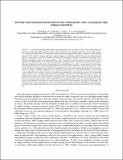| dc.contributor.author | Burdick, S. | |
| dc.contributor.author | de Hoop, Maarten | |
| dc.contributor.author | Wang, S. | |
| dc.contributor.author | van der Hilst, Robert D | |
| dc.date.accessioned | 2014-10-09T20:36:47Z | |
| dc.date.available | 2014-10-09T20:36:47Z | |
| dc.date.issued | 2013-11 | |
| dc.date.submitted | 2012-10 | |
| dc.identifier.issn | 0956-540X | |
| dc.identifier.issn | 1365-246X | |
| dc.identifier.uri | http://hdl.handle.net/1721.1/90857 | |
| dc.description.abstract | Converted and multiply reflected phases from teleseismic events are routinely used to create structural images of the crust–mantle boundary (Moho) and the elasticity contrasts within the crust and upper mantle. The accuracy of these images is to a large extent determined by the background velocity model used to propagate these phases to depth. In order to improve estimates of 3-D velocity variations and, hence, improve imaging, we develop a method of reverse-time migration-based reflection tomography for use with wavefields from teleseismic earthquakes recorded at broad-band seismograph arrays. Reflection tomography makes use of data redundancy—that is, the ability to generate numerous structural images of the subsurface with different parts of the wavefield. In exploration seismology (where it is known as migration velocity analysis) reflection tomography typically involves the generation of an extended image (e.g. offset- or angle-gathers), and the fitness of the background model is evaluated through the application of image-domain annihilators. In regional-scale passive source seismology, however, annihilation-based methods are inadequate because the sparse and irregular distribution of teleseismic sources is not likely to produce illumination over a sufficient range of angles. To overcome this problem we turn towards a source-indexed moveout scheme. Instead of extended image annihilation, we determine the success of the tomographic velocity model by cross correlating images produced with multiply scattered waves from different teleseismic sources. The optimal velocity model is the one that minimizes correlation power between windowed images away from zero depth shift. We base our inversion scheme on the seismic adjoint method and a conjugate gradient solver. For each image pair, the update direction is determined by correlations between downgoing wavefields with upgoing adjoint wavefields for both images. The sensitivity kernels used in this method is similar to those found in other forms of adjoint tomography, but their shapes are controlled by the spatial distribution of the error function. We present the method and a proof-of-concept with 2-D synthetic data. | en_US |
| dc.language.iso | en_US | |
| dc.publisher | Oxford University Press on behalf of The Royal Astronomical Society | en_US |
| dc.relation.isversionof | http://dx.doi.org/10.1093/gji/ggt428 | en_US |
| dc.rights | Creative Commons Attribution-Noncommercial-Share Alike | en_US |
| dc.rights.uri | http://creativecommons.org/licenses/by-nc-sa/4.0/ | en_US |
| dc.source | van der Hilst via Michael Noga | en_US |
| dc.title | Reverse-time migration-based reflection tomography using teleseismic free surface multiples | en_US |
| dc.type | Article | en_US |
| dc.identifier.citation | Burdick, S., M. V. de Hoop, S. Wang, and R. D. v. d. Hilst. “Reverse-Time Migration-Based Reflection Tomography Using Teleseismic Free Surface Multiples.” Geophysical Journal International 196, no. 2 (November 7, 2013): 996–1017. | en_US |
| dc.contributor.department | Massachusetts Institute of Technology. Department of Earth, Atmospheric, and Planetary Sciences | en_US |
| dc.contributor.approver | van der Hilst, Robert D. | en_US |
| dc.contributor.mitauthor | van der Hilst, Robert D. | en_US |
| dc.contributor.mitauthor | Burdick, S. | en_US |
| dc.relation.journal | Geophysical Journal International | en_US |
| dc.eprint.version | Author's final manuscript | en_US |
| dc.type.uri | http://purl.org/eprint/type/JournalArticle | en_US |
| eprint.status | http://purl.org/eprint/status/PeerReviewed | en_US |
| dspace.orderedauthors | Burdick, S.; de Hoop, M. V.; Wang, S.; Hilst, R. D. v. d. | en_US |
| dc.identifier.orcid | https://orcid.org/0000-0003-1650-6818 | |
| mit.license | OPEN_ACCESS_POLICY | en_US |
| mit.metadata.status | Complete | |
